- Create an Account
- Back Issues ::
- Year 2006 (Issues 37-42) ::

Reprint of Aquarius 23 Boat Review from Issue No. 37
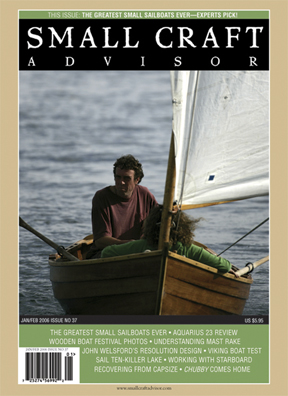
- New Sailboats
- Sailboats 21-30ft
- Sailboats 31-35ft
- Sailboats 36-40ft
- Sailboats Over 40ft
- Sailboats Under 21feet
- used_sailboats
- Apps and Computer Programs
- Communications
- Fishfinders
- Handheld Electronics
- Plotters MFDS Rradar
- Wind, Speed & Depth Instruments
- Anchoring Mooring
- Running Rigging
- Sails Canvas
- Standing Rigging
- Diesel Engines
- Off Grid Energy
- Cleaning Waxing
- DIY Projects
- Repair, Tools & Materials
- Spare Parts
- Tools & Gadgets
- Cabin Comfort
- Ventilation
- Footwear Apparel
- Foul Weather Gear
- Mailport & PS Advisor
- Inside Practical Sailor Blog
- Activate My Web Access
- Reset Password
- Pay My Bill
- Customer Service

- Free Newsletter
- Give a Gift

How to Sell Your Boat

Cal 2-46: A Venerable Lapworth Design Brought Up to Date

Rhumb Lines: Show Highlights from Annapolis

Open Transom Pros and Cons

Leaping Into Lithium

The Importance of Sea State in Weather Planning

Do-it-yourself Electrical System Survey and Inspection

Install a Standalone Sounder Without Drilling

Rethinking MOB Prevention

Top-notch Wind Indicators

The Everlasting Multihull Trampoline

In Search of the Snag-free Clew

What’s Involved in Setting Up a Lithium Battery System?

Reducing Engine Room Noise

Breaking Point: What Can Go Wrong With Your Yanmar?

Mildew-resistant Caulks for Boats

Can We Trust Plastic Boat Parts?

Repairing Molded Plastics

Mailport: Marine plywood, fuel additives, through bolt options, winch handle holders

The Day Sailor’s First-Aid Kit

Choosing and Securing Seat Cushions

Cockpit Drains on Race Boats

Rhumb Lines: Livin’ the Wharf Rat Life

Resurrecting Slippery Boat Shoes

Shoe Goo’s Gift to Sailors

Tricks and Tips to Forming Do-it-yourself Rigging Terminals

Marine Toilet Maintenance Tips

Learning to Live with Plastic Boat Bits

The Ultimate Guide to Caring for Clear Plastic
- Sailboat Reviews
Four Trailer-Sailers And the Keel/Launch Problem
The paceship 23, american 26, yankee pacific dolphin 24, and aquarius 23 represent different solutions to the problem of easy launching.
In the early 1970s, when the fiberglass sailboat revolution was in full swing, so were the so-called swing keels. Three years after Richard Nixon was elected president, partly on the promise of ending the Vietnam War, U.S. planes still were bombing Cambodia, hippies and peaceniks were marching and both were flashing the V sign. In 1971 Sylvia Plath published “The Bell Jar,” Louis Armstrong died, the crews of Apollo 14 and 15 landed on the moon, cigarette advertisements were banned from television, and Joe Frazier outpointed Muhammad Ali to retain his world heavyweight boxing title.
On the domestic level, Americans were taking their leisure time more seriously than ever, taking to the highways in RVs and to the waterways in all sorts of new fiberglass boats. Magazines devoted exclusively to sailing began to appear. One of the most popular type of boats was the “trailersailer,” relatively light-displacement sloops with centerboards and swing keels, that could be stored in the backyard or driveway, towed behind the family station wagon and launched in about 45 minutes. Trailer-sailers promised yacht-style accommodations at an affordable price-in terms of both initial investment and annual upkeep.
Trailer-sailers never really disappeared from the sailing scene, but they haven’t been exactly an exploding market force either. But becuase we see indications that trailer-sailers are showing signs of increased interest from boat buyers, we thought we’d take a look at four early-and mid-19702 designs.
The Ballast Problem
For stability, a sailboat must have an underwater appendage such as a keel or centerboard, and ballast. Both are at odds with the concept of an easily trailerable boat that can be launched at most ramps. A deep fixed keel is untenable. One solution is to design a long, shallow keel, as seen on many Com-Pac boats, and older models such as the O’Day22. Unfortunately, windward performance suffers because there is little leading edge and foil shape to provide lift.
During the last few years, several builders have experimented with water ballast in the hull and centerboards for lift. Notable designs include the MacGregor 26, Hunter 23.5 and 26, and the new Catalina 25. The idea is to dump the ballast on haul-out to minimize trailering weight, especially important given the small size of the average car these days. The drawback, as we see it, is that the water ballast works best when it is well outboard, which is the case on race boats with port and starboard ballast tanks. Trailer-sailers with shallow ballast tanks on centerline can’t obtain the same righting moments because of the short righting arm. Plus, saltwater is not very dense, just 64 pounds per cubic foot (62.4 lbs. for fresh), compared to lead at about 708 lbs. While waterballast may be a viable option for lake and protected-water sailors, we don’t think it’s the best solution.
Looking back at the Paceship PY 23, American 26, Yankee Dolphin24, and Aquarius 23-we can examine several other approaches to the same problem.
Paceship Yachts was originally a Canadian builder, located in Mahone Bay, Nova Scotia (it was later bought by AMF of Waterbury, Connecticut). One of its first boats was the popular East Wind 24, introduced in 1963. The PY 23, designed by John Deknatel of C. Raymond Hunt Associates, was developed in 1974 in response to the trailer-sailer boom.
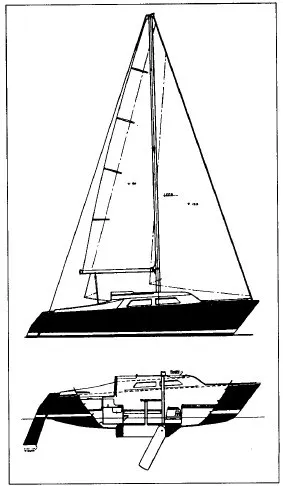
An early brochure describes the PY 23 as “a second generation refinement of the trailerable concept which eliminates the awkwardness in handling and sailing often present in the early trailerables.” Indeed, the boat was rated 18.0 for IOR Quarter Ton and 16. 9 under the MORC rule. Modern looks were derived largely from the flat sheer and reverse transom.
Instead of the more common swing keel, in which all of the boat’s ballast hangs on a single pivot pin, Deknatel gave the PY 23 a 40-pound centerboard that retracts into a 900-pound “shallow draft lineal keel.” This arrangement eliminates a trunk intruding into the cabin space, and places the majority of ballast a bit lower (it draws 1′ 9″ board up) than in boats, such as the Aquarius 23, in which the ballast is simply located under the cabin sole. The downside is a bit more draft, which means you need to get the trailer that much deeper to float the boat on and off. (We once owned a Catalina 22, which draws 2′ 0″ keel up, and often had to use a trailer tongue extension-built in-to launch and haul out.) Based on our experience, any draft under 2 feet should be relatively easy to trailer and launch. Difficulties seem to mount exponentially with every inch of added draft.
Like most trailer-sailers, the PY 23 has an outboard rudder that kicks up for beaching.
Recognizing that trailer-sailers are not built for rugged conditions, and that by necessity they are not big boats, we herewith list some of the more common owner complaints: no backrests in cabin, barnacles in centerboard well, not enough room in head, not an easily trailerable boat, rudder rot, and poor ventilation in forepeak.
On the plus side, owners say the boat is quick, well built, balances well, has good-quality mast and rigging, a comfortable cockpit, and a livable interior.
In all, we think this is a good example of the trailer-sailer. We like the keel/centerboard arrangement, even though it adds a few precious inches to board-up draft. It sold in 1974 for $8,150 base. Today, it would sell for about $5,100. A superior choice in our book.
Yankee Pacific Dolphin 24
Yankee Yachts of Santa Ana, California, was a major builder during the 1970s, known mostly for its IOR boats. The Pacific Dolphin 24, designed by Sparkman & Stephens, is a classiclooking boat, not unlike the more familiar S&S-designed Tartan 2 7. It was built between about 1969 and 1971, when it was replaced by the Seahorse 24, designed by Robert Finch, who helped design the immensely successful Catalina 27.
The reason, we surmise, was that the Dolphin has a long keel drawing 2′ 10″, and though the company initially thought it would appeal to trailersailers, it’s draft, plus 4,250-pound displacement, made it difficult to launch and retrieve. In contrast, the Seahorse drew 1′ 8″, displaced 2,800 pounds, and has a scabbard-type removable rudder.
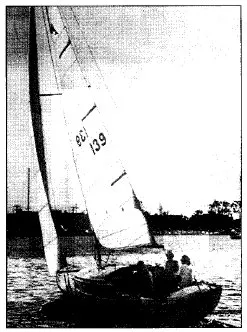
The Dolphin has 1,750 pounds of ballast, all in the keel. The attached rudder makes this boat a bit more rugged than most trailer-sailers, and its overall quality, including extensive teak joinerwork below, places it in a different category.
Owners report very few problems with the Dolphin other than a comparatively large turning radius, and cramped living quarters; most have only good things to say. An Oregon owner said, “Using a 3/4-ton pickup with a 390 engine we go uphill at 30 mph and down at 55. It takes us a couple of hours to rig and get underway, but it sure beats paying slip fees.” He also cites the Dolphin’s speed, saying he keeps pace with a Cal34, trounces a Balboa 26 and Catalina 27, and has only “lost” to a San Juan 21 going upwind. A Washington owner says she is very seakindly, with just the right amount of helm, though a bit tender due to narrow beam. Most owners use a 6-hp. outboard in the well, though one said he opted for a 15-hp. outboard for better performance, and because it can charge the batteries. Construction is reported as heavy.
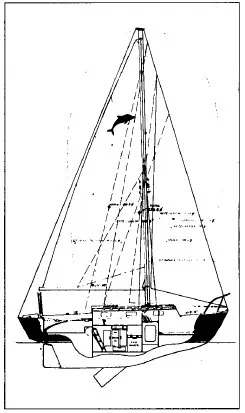
In 1971 the boat sold new for $5,995.Prices now are around $7,500, which for an original owner would have made it the best investment of these four boats. While we have always liked the Dolphin, we don’t view it as suitable for regular trailering. More likely, you’d keep it at a slip during the sailing season, parking it at home on its trailer after haul-out.
American 26
Costa Mesa, California was the epicenter of 1970s boatbuilding. American Mariner Industries is one company, however, better forgotten. It was in business from about 1974 to 1983. Its American 26 was a 25 first. A 1974 brochure says, “This 25-footer so completely justified our judgment as to the efficacy of our unique stabilizer keel and hull . . . that we have moved on to provide the trail-and-sail cruising enthusiast with a choice of two versions-the American 23 and the American 26.” This seems to imply that the same hull mold was used.
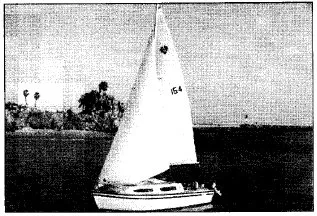
In any case, what is unique about this line of boats is the wide, partly hollow keel that makes a sort of trough in the cabin sole to provide standing headroom. It is not wide, but does run nearly the length of the main cabin. Ballast is 900 pounds of lead laid in the bottom of the keel. Draft is 2′ 4″ for trailerability, but there is no centerboard, and due to the keel’s extreme width, you can imagine that windward performance is poor. Unfortunately, we have no owner feedback on this boat to corroborate our assessment.
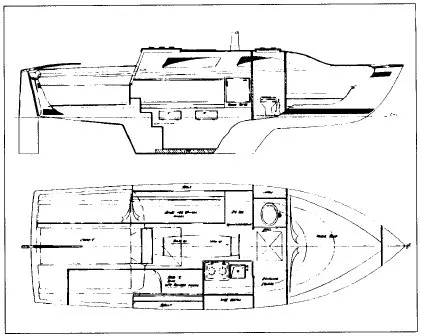
The boat sold new in 1974 for $8,995 base. The BUC Research Used Boat Price Guide says today it’s worth about $6,000. Frankly, this design, which severely compromises sailing performance for standing headroom, seems ill-conceived. One can only guess at how many people have cracked their skulls stepping up out of the trough.
Aquarius 23
Coastal Recreation, Inc., also of Costa Mesa, was around from about 1969 to 1983. It acquired the Balboa line of trailer-sailers, and for a time built the LaPaz 25 motorsailer.
The Aquarius 23, and its smaller sistership the Aquarius 21, were designed by Peter Barrett, a Webb Institute graduate and national champion in Finns and 4 70s. The Aquarius 23 is not much prettier to look at than the American 26, though it sails surprisingly well. Because highway trailering laws restrict the beam to 8 feet, the Aquarius 23 comes in just under at 7′ 11″ and relies on it for stability. ” Most of the 815 pounds of ballast is in the hull. A large center- board retracts fully into a trunk, which is more or less concealed in the cabin as a foundation for the drop-leaf table. A peculiarity is that persons sitting at the table are all on the starboard side, and the forward person is forward of the main bulkhead, essentially in the head, though there is a fore-andaft bulkhead making the toilet reasonably private (another important issue for trailersailers).
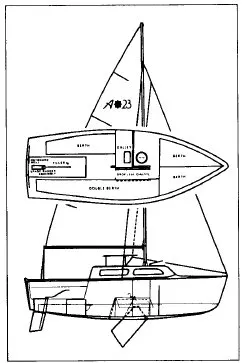
Like the Paceship PY 23 and many other trailer-sailers, the Aquarius 23 has a pop-top to provide additional headroom. We think this is more sensible than the American’s keel trough, but we do caution that pop tops can leak and aren’t designed for offshore use.
Another unusual feature of the Aquarius is the absence of a backstay and spreaders. To support the mast, the shrouds are led aft, reflecting, we suppose, Barrett’s one-design background. If not suited for wild and woolly sailing conditions, it is at least simple to set up, and that, after all, is the goal of most trailer-sailers.
Friends of ours bought an Aquarius 23 in 1970, and we spent a good deal of time sailing with them, including several overnight crossings of Lake Michigan. The boat handled well, was reasonably quick on a reach, and had more interior room than most 23-footers. Still, we were never enamored of its looks.
Complaints from owners include lost centerboards and rudder repairs (like the Yankee Seahorse, it is an inside, removable type), poor ventilation, poor windward performance when overloaded, tubby appearance, and lack of a mainsheet traveler. Many owners say they bought the boat for its shoal draft and large interior, but that cheap construction caused numerous problems.
The Aquarius 23, in the early 1970s, sold for $6,195; today it sells for about $4,000. Though our memories of sailing this boat are all rosy, we think there are better boats available.
Our preferred solution to the keel/ ballast problem in trailer-sailers is the traditional keel/centerboard as found on the PY 23, Tanzer22 andO’Day23, all of which we recommend. The keel/ centerboard configuration eliminates the trunk in the cabin, places ballast below the hull, and does not concentrate all of the ballast weight on a pivot pin, as is the case with swing-keel designs.
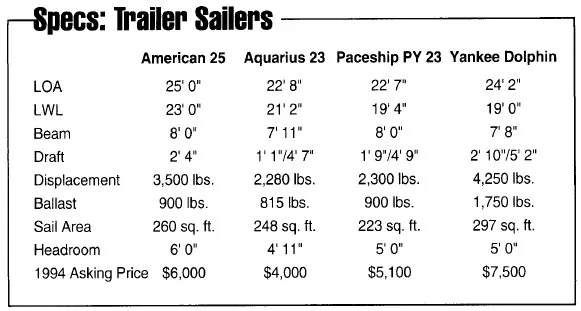
We do not care for the American 26’s hollow keel, believing that if you want standing headroom, either go outside or buy a bigger boat. Nor do we care particularly for narrow shoal keels without centerboards, because windward performance suffers, or boards that leave all the ballast in the hull-whether lead, iron or water-as ultimate stability is compromised.
How one solves the choice between interior space and sailing performance is a personal decision. We, too, appreciate spaciousness down below, but at the same time have always chosen boats that looked and sailed decently, willing to give up a few inches of elbow room for a boat we could feel proud of when rowing away in the dinghy.
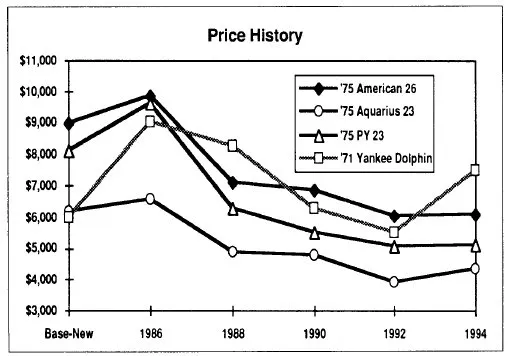
RELATED ARTICLES MORE FROM AUTHOR
So the only real complaint against the Aquarius23 is the author is not “enamoured” with it’s “looks”, whatever that means.
I think the Aquarius 23 beats them all for what they were designed for. A family of 5 and thats just what I have. The wide stern and blunt bow make it Large inside and can take a lot of wieght in the tail. I need function, rugged keel for beaching and shallow waters.
I had an Aquarius 21 for thirteen years in San Diego. I sailed it all the time, and made four trips to Catalina Island in it. It had some poor constructions flaws (like particle board coring for the deck), but it was inexpensive, and easily handled by one person. I loved it.
Hi Kevin. I’m looking at a Aquarius 21 project boat. The owner lost the title so I would have to re-title it, but can find a VIN / serial # anywhere. Can you tell me where it might be located?
I have owned and sailed a PY 23 for twenty years, and she has served me well. I have had off and on trouble lowering the centerboard, as it easily sticks in the up position (likely due to growths inside the trunk). It is difficult to gain enough leverage from inside the cabin to force it down. Other than that – the boat has been a trooper.
Have you ever evaluated the Sirius 21/22?
How about a review of the Sirius 21/22 by Vandestad and McGrewer?

LEAVE A REPLY Cancel reply
Log in to leave a comment
Latest Videos
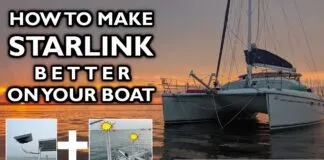
How To Make Starlink Better On Your Boat | Interview

Catalina 380: What You Should Know | Boat Review
- Privacy Policy
- Do Not Sell My Personal Information
- Online Account Activation
- Privacy Manager
Review of Aquarius 23 Mk II
Basic specs..
The Aquarius 23 Mk II has been built with more than one type of keel. One option is a finn keel. The finn keel is the most common keel and provides splendid manoeuvrability. The downside is that it has less directional stability than a long keel.
The boat can enter even shallow marinas as the draft is just about 1.13 - 1.23 meter (3.71 - 4.01 ft) dependent on the load. See immersion rate below.
Sailing characteristics
This section covers widely used rules of thumb to describe the sailing characteristics. Please note that even though the calculations are correct, the interpretation of the results might not be valid for extreme boats.
What is Capsize Screening Formula (CSF)?
The capsize screening value for Aquarius 23 Mk II is 2.31, indicating that this boat would not be accepted to participate in ocean races.
What is Theoretical Maximum Hull Speed?
The theoretical maximal speed of a displacement boat of this length is 6.2 knots. The term "Theoretical Maximum Hull Speed" is widely used even though a boat can sail faster. The term shall be interpreted as above the theoretical speed a great additional power is necessary for a small gain in speed.
The immersion rate is defined as the weight required to sink the boat a certain level. The immersion rate for Aquarius 23 Mk II is about 104 kg/cm, alternatively 583 lbs/inch. Meaning: if you load 104 kg cargo on the boat then it will sink 1 cm. Alternatively, if you load 583 lbs cargo on the boat it will sink 1 inch.
Sailing statistics
This section is statistical comparison with similar boats of the same category. The basis of the following statistical computations is our unique database with more than 26,000 different boat types and 350,000 data points.
What is Motion Comfort Ratio (MCR)?
What is L/B (Length Beam Ratio)?
What is Displacement Length Ratio?
What is SA/D (Sail Area Displacement ratio)?
Maintenance
When buying anti-fouling bottom paint, it's nice to know how much to buy. The surface of the wet bottom is about 17m 2 (182 ft 2 ). Based on this, your favourite maritime shop can tell you the quantity you need.
Are your sails worn out? You might find your next sail here: Sails for Sale
If you need to renew parts of your running rig and is not quite sure of the dimensions, you may find the estimates computed below useful.
This section shown boat owner's changes, improvements, etc. Here you might find inspiration for your boat.
Do you have changes/improvements you would like to share? Upload a photo and describe what to look for.
We are always looking for new photos. If you can contribute with photos for Aquarius 23 Mk II it would be a great help.
If you have any comments to the review, improvement suggestions, or the like, feel free to contact us . Criticism helps us to improve.

FIND US | Call us on (07) 3890 2322
“Always Buying, Consigning and Selling Queensland’s Best Used Boats Since 1964”
Folder Aquarius 23
Pdf aquarius 23 brochure and specifications popular.
Published on 04 February 2009 5320 downloads
aquarius_23_ Brochure_&_specifications_wm.pdf
Image Aquarius 23 Photo 1 Popular
Published on 13 March 2009 3713 downloads
aquarius_23_photo_1.jpg
Image Aquarius 23 Photo 2 Popular
Published on 13 March 2009 5176 downloads
aquarius_23_photo_2.jpg
Image Aquarius 23 Photo 3 Popular
Published on 13 March 2009 5294 downloads
aquarius_23_photo_3.jpg
pdf Aquarius 23 Price List Popular
Published on 04 February 2009 3395 downloads
aquarius_ 23_Price_list_wm.pdf
Call us on (07) 3890 2322
1029 Manly Road, Tingalpa, Queensland, Australia [email protected]
Website design by Marketeam
Copyright © 2017 John Crawford Marine – Queensland's Used Boat Specialists

- Forum Listing
- Marketplace
- Advanced Search
- About The Boat
- Gear & Maintenance
- SailNet is a forum community dedicated to Sailing enthusiasts. Come join the discussion about sailing, modifications, classifieds, troubleshooting, repairs, reviews, maintenance, and more!
Aquarius 23 Question
- Add to quote
Hi. My name is Mike and I just bought an Aqaurius 23. I would like to buy/make a new "camper top." I am not sure if that is what it is called. From pictures I have seen it looks like the original was canvas and misquito netting. We would like to spend some weekends on the boat this summer so I have to figure out how to buy/make one. Any suggestions would be greatly appreciated. Thanks.
It's called a Dodger. Yes, they are canvas and clear vinyl for the windows. They attach to the hatch and to the deck with snaps. Join the Aquarius forum here: http://groups.yahoo.com/group/Aquarius-owners/ Tons of great info, big archive and lots of pics. BTW...I have a 72 Aquarius 23. Where in Nebraska are you? I grew up in Ogallala. Andy
Andyman- I think he's talking more about a cockpit enclosure, rather than a dodger. Most dodgers don't have mosquito netting. The Aquarius 23 is small enough that the cabin space is a bit lacking, and a cockpit enclosure would give the boat a lot more living space. Some boats have this as an option, like the Gemini catamarans have a soft-sided cockpit enclosure available to make more living space when at anchor or at the dock. Mike- Your best bet may be to contact the manufacturer of the boat if they're still in business, or lacking that, contact an Owner's users group or association, if they have one for your boat. That is probably the fastest and easiest way of finding out how to get a replacement enclosure, if one was normally available for the boat. However, the enclosure may have been an owner added modification, and as such, basically custom for your specific boat—in which case neither the company or the owner's association will be of much help. Contacting a local canvas shop might be a good third alternative.
Nah, Nebraska Mike's talkin' about the canvas that goes around the perimeter of the pop-top on the Aquarius 23...like the top on a Catalina 22 or 25, to give it more interior headroom. I'd suggest printing a few pictures of the rig from the internet and showing them to someone who specializes in doing boat canvas (covers, dodgers, biminis, etc.).
and...drops down and covers up the companionway with a zippered opening....called a dodger, no? Click to expand...
Thanks for the information I am talking about a cover for the pop-top.
I live in Omaha. Where do you live now?
I live in Medford, Oregon. BTW...here's the link to the Aquarius Yahoo forum. http://groups.yahoo.com/group/Aquarius-owners/ Go join...it's a good group of A21 and A23 owners with lots of stuff in the archives. Where are you sailing in the Omaha area?
The pop-top enclosier would be easy enought to make. The wife and I do a good number of Canvas repairs, modifications, and builds while we are out cruising..Check out the Sailrite website for the how-tos.. A simple framework and a cover.... I'd think you could do the project yourself.
I have patterns for the A23, a canvas shop can make them easily from the patterns, you will just need to line up snaps, ez.
- ?
- 173.7K members
Top Contributors this Month
Great choice! Your favorites are temporarily saved for this session. Sign in to save them permanently, access them on any device, and receive relevant alerts.
- Sailboat Guide
1973 Aquarius 23
- Description
Seller's Description
The owner bought this boat in 2010
General condition and any additional information
without question, this vessel provides absolute live aboard comfort with infinite range. minimal operating and maintenance costs. Wickford RI mooring ball available summer 2020
Standard features
The Aquarius 23 has a roomy 8 ft. Beam and a swing keel. The boat was designed as a day sailer with a minimal interior. Vessel was gutted in 2010/2011 and completely refittedwith a Beneteau 23 inspired interior to the turn of $30k+.Insanity, of course. Having downgraded from a Cabo Rico 38, I still wanted the amenities and comfort of a big boat Plus trailerability. I have enjoyed 8 summers on board everywhere from Chesapeake Bay. Georgian Bay, Ontario, Lake Champlain, Narragansett Bay (5 summers). Now past 80, its time to let others enjoy Perfect Timing.
Extra gear included
One person electric mast raising system. Any boat ramp, anywhere Electronics: Pro Tech 1230i Plus Battery Charger West Marine VHF DSC Marine Radio Dual MXCP 43 digital media marine receiver Garmin GPSMAP 400/500 Series Depth sounder Ritchie Compass Venture SR2 2 sets fitted V berth sheets 2- 224 amp hour gel batteries new window coverings 2019 2 self inflating life vests + life jackets Dock fenders and dock lines wind scoop. Additional items: Custom aluminum dual axle trailer $1900. 11 foot Zodiac with 6 hp 4 cycle Mercury outboard $900.
Improvements to the hull, deck, rigging, engine, or interior
Exterior:Complete Awlgrip exterior. New rigging, Roller furling genoa, main and cover (2019), SS Bimini and stern pulpit, built in anchor locker, cockpit lazarette, Bomar 20 x 20 forward hatch, nylon hand rails, Lexan companionway cover, custom canvas dodger, ( standing headroom in galley area). Bimini top and extension cockpit cover, custom cockpit cushions. 15 gal. fuel tank. 9.8 4 Cycle long shaft electric start Tahatsu outboard. Interior: Custom seat cushions, Porta Potti, full extension under berth drawers for easy access, dining for 5 in salon, complete galley including built in 3+ cu. ft. ice box, alcohol stove, pot and pan locker, 2 huge full extension food and accessory drawers, large sink 16 x 18 x 9 deep (spaghetti pot size) , under sink trash bin and cleaning supplies. Standing head room in galley( essential for live aboard). Electronics tower, 15 bottle build in wine storage. 4 LED gooseneck cabin lights.
Rig and Sails
Auxilary power, accomodations, calculations.
The theoretical maximum speed that a displacement hull can move efficiently through the water is determined by it's waterline length and displacement. It may be unable to reach this speed if the boat is underpowered or heavily loaded, though it may exceed this speed given enough power. Read more.
Classic hull speed formula:
Hull Speed = 1.34 x √LWL
Max Speed/Length ratio = 8.26 ÷ Displacement/Length ratio .311 Hull Speed = Max Speed/Length ratio x √LWL
Sail Area / Displacement Ratio
A measure of the power of the sails relative to the weight of the boat. The higher the number, the higher the performance, but the harder the boat will be to handle. This ratio is a "non-dimensional" value that facilitates comparisons between boats of different types and sizes. Read more.
SA/D = SA ÷ (D ÷ 64) 2/3
- SA : Sail area in square feet, derived by adding the mainsail area to 100% of the foretriangle area (the lateral area above the deck between the mast and the forestay).
- D : Displacement in pounds.
Ballast / Displacement Ratio
A measure of the stability of a boat's hull that suggests how well a monohull will stand up to its sails. The ballast displacement ratio indicates how much of the weight of a boat is placed for maximum stability against capsizing and is an indicator of stiffness and resistance to capsize.
Ballast / Displacement * 100
Displacement / Length Ratio
A measure of the weight of the boat relative to it's length at the waterline. The higher a boat’s D/L ratio, the more easily it will carry a load and the more comfortable its motion will be. The lower a boat's ratio is, the less power it takes to drive the boat to its nominal hull speed or beyond. Read more.
D/L = (D ÷ 2240) ÷ (0.01 x LWL)³
- D: Displacement of the boat in pounds.
- LWL: Waterline length in feet
Comfort Ratio
This ratio assess how quickly and abruptly a boat’s hull reacts to waves in a significant seaway, these being the elements of a boat’s motion most likely to cause seasickness. Read more.
Comfort ratio = D ÷ (.65 x (.7 LWL + .3 LOA) x Beam 1.33 )
- D: Displacement of the boat in pounds
- LOA: Length overall in feet
- Beam: Width of boat at the widest point in feet
Capsize Screening Formula
This formula attempts to indicate whether a given boat might be too wide and light to readily right itself after being overturned in extreme conditions. Read more.
CSV = Beam ÷ ³√(D / 64)
Weight of keel: 165 lbs. Similar to BALBOA 23. Re-introduced (1976?) as the AQUARIUS 7.0 with modifications including transom mounted rudder.
Dimensions for alternative masthead rig: I:25.3’ J:8.7’ P:22.7’ E:10.7’
This listing is presented by SailboatOwners.com . Visit their website for more information or to contact the seller.
View on SailboatOwners.com
Embed this page on your own website by copying and pasting this code.
- About Sailboat Guide
©2024 Sea Time Tech, LLC
This site is protected by reCAPTCHA and the Google Privacy Policy and Terms of Service apply.
A Journey Begins Aboard an Aquarius 23' Sailboat
Adventures in sailing as I teach myself how to sail exploring the Puget Sound of Washington State aboard an Aquarius 23. Learning to sail the Pacific Northwest.
Thursday, March 27, 2014
Some interrior pictures.
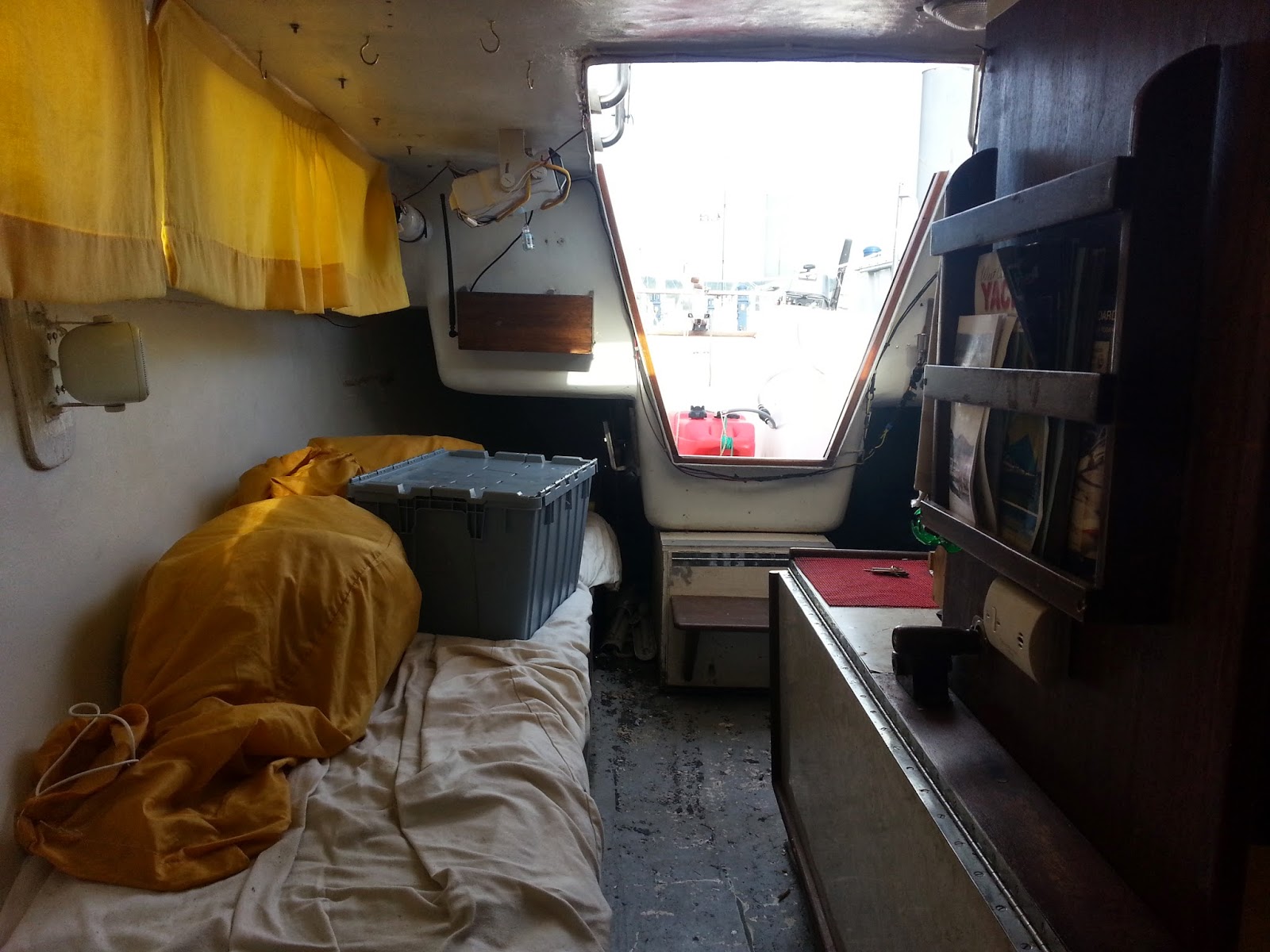
Monday, August 12, 2013
Back in the water.
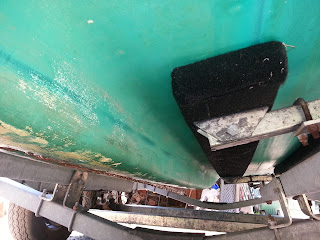
Tuesday, July 30, 2013
Up on the hard, saturday, july 27, 2013, a three hour tour... (insert gilligans island theme music here), wednesday, july 24, 2013.
AQUARIUS 21 Detailed Review
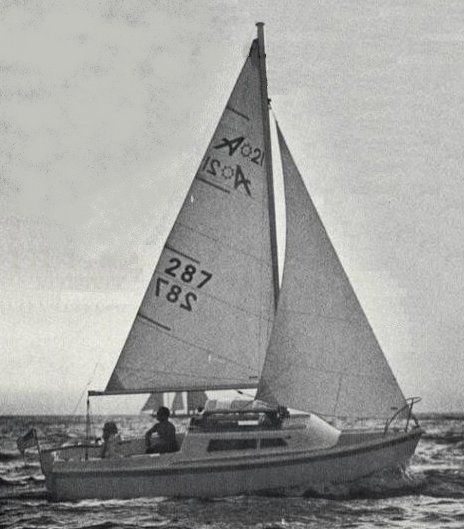
If you are a boat enthusiast looking to get more information on specs, built, make, etc. of different boats, then here is a complete review of AQUARIUS 21. Built by Coastal Recreation Inc. and designed by Peter Barrett, the boat was first built in 1969. It has a hull type of Keel/Cbrd. and LOA is 6.4. Its sail area/displacement ratio 17.04. Its auxiliary power tank, manufactured by undefined, runs on undefined.
AQUARIUS 21 has retained its value as a result of superior building, a solid reputation, and a devoted owner base. Read on to find out more about AQUARIUS 21 and decide if it is a fit for your boating needs.
Boat Information
Boat specifications, sail boat calculation, rig and sail specs, contributions, who designed the aquarius 21.
AQUARIUS 21 was designed by Peter Barrett.
Who builds AQUARIUS 21?
AQUARIUS 21 is built by Coastal Recreation Inc..
When was AQUARIUS 21 first built?
AQUARIUS 21 was first built in 1969.
How long is AQUARIUS 21?
AQUARIUS 21 is 5.56 m in length.
What is mast height on AQUARIUS 21?
AQUARIUS 21 has a mast height of 5.94 m.
Member Boats at HarborMoor

- Forums New posts Unanswered threads Register Top Posts Email
- What's new New posts New Posts (legacy) Latest activity New media
- Media New media New comments
- Boat Info Downloads Weekly Quiz Topic FAQ 10000boatnames.com
- Classifieds Sell Your Boat Used Gear for Sale
- Parts General Marine Parts Hunter Beneteau Catalina MacGregor Oday
- Help Terms of Use Monday Mail Subscribe Monday Mail Unsubscribe
Aquarius 23 New Owner
- Thread starter Harmons
- Start date Oct 25, 2016
- Brand-Specific Forums
Hello, I am new to this forum and am a new owner to an 1976 Aquarius 23, the boat is in pretty good shape for the year, it was closed up and not used for 6 years. I am currently removing all interior fabric to get rid of mold / rotten fabric I will be painting the interior for now and moving forward at a later date with replacing the fabric. My questions first would be the winch for the keel it seems small for the keel, in some photo's that I've seen the winch is larger not sure if the larger winch is after market? The boat does not have, that I can tell a bilge but a self bailer? This is a crazy question, how do you lock the pop top, so it will stay up? And lastly what does the back stay anchor to? I do not have any paperwork with the boat. Thank you for being understanding with a new sailor. Harmons
Bill Murray
I had a 1973 A23 for 16 years. Here is my advice... join this group.... https://beta.groups.yahoo.com/neo/groups/Aquarius-owners/info?referrer=chinatownfresno These guys know everything there is to know about Aquarius boats. Also join this group... https://beta.groups.yahoo.com/neo/groups/Coastal-Recreation-Inc/info They know everything the first group knows and more... answers to questions -- the winch is a small brass one way winch with a removable handle. That is all you need. The "keel" is not a keel but rather a steel centerboard. The keel consists of lead encapsulated in the hull mold and runs the length of the hull. Some folks replaced the winch but I never had a failure experience. Info on frozen centerboards, restoration of rusted centerboards, etc and replacement of hinge pins can be found at the group site. There is not a bilge. originally the carpeting was laid directly on the hull interior. I fooled with a bilge pump but found a sponge and vigilance about water getting in worked best. I replaced teh carpet with teak grates in all the walkways. The backstay is a split backstay with the split occuring about 6 ft.above the coamings. Each end attached to a chainplate at the outboard corners of the transom. Some A23s were built without a backstay but I believe they were all earlier models than yours. Have fun - these are fun little boats.
Also you find original owners manuals, rigging instruction and sales brochures in the files on t his site too https://beta.groups.yahoo.com/neo/groups/Coastal-Recreation-Inc/info?referrer=olympicdolphin https://beta.groups.yahoo.com/neo/groups/Aquarius-owners/files/A23 7.0 (1978) Brochure/ and lots more....
Here is the owners manual -- rigging and set up instructions... https://groups.yahoo.com/neo/groups/Aquarius-owners/files/A21&A23 Manual/
- This site uses cookies to help personalise content, tailor your experience and to keep you logged in if you register. By continuing to use this site, you are consenting to our use of cookies. Accept Learn more…

IMAGES
VIDEO
COMMENTS
The age of Aquarius. The Aquarius sailboat was built in Costa Mesa CA. Starting with the Aquarius 23, the boat was designed by Peter Barrett (who later worked with North Sails and also designed the C&C Mega 30). There also was an Aquarius 21, an Ensenada 20, a LaPaz 25 that were offered as trailerable boats.
It takes into consideration "reported" sail area, displacement and length at waterline. The higher the number the faster speed prediction for the boat. A cat with a number 0.6 is likely to sail 6kts in 10kts wind, a cat with a number of 0.7 is likely to sail at 7kts in 10kts wind. KSP = (Lwl*SA÷D)^0.5*0.5
Aquarius 23 - Possibly my first "big" boat ! I've been looking at a 1973 Aquarius 23 foot boat as my first real sail boat. I've sailed a 15 foot Mcgregor beach cat for a few years, but am ready for something that me and my wife and two little kids can learn on, as well as spend a long weekend aboard. I personally would love something bigger ...
If you are a boat enthusiast looking to get more information on specs, built, make, etc. of different boats, then here is a complete review of AQUARIUS 23. Built by Coastal Recreation Inc. and designed by Peter Barrett, the boat was first built in 1969. It has a hull type of Swing Keel and LOA is 6.91. Its sail area/displacement ratio 20.18.
Review of Aquarius 23. Basic specs. The Aquarius 23 aka Balboa 23 is a small sailboat designed by the American maritime architect Peter Barrett in the late sixties. The Aquarius 23 is built by the American yard Coastal Recreation Inc.. Here we would have liked to show you nice photos of the Aquarius 23.
The Aquarius 23 is an American trailerable sailboat that was designed by Peter Barrett and Stan Miller as a cruiser and first built in 1969. ... In a 2010 review Steve Henkel faulted the boat's aesthetics, writing, "because the freeboard is very high, partly to provide more than usual headroom for a 23-foot boat, she looks high and boxy." ...
My First Time Sailing in 10 years, second time in my life (first time was a lesson 10 year ago). Should be fine to go out solo in this old 1972 Coastal Recr...
Aquarius 23 is a 22′ 8″ / 6.9 m monohull sailboat designed by Peter Barrett and built by Coastal Recreation Inc. between 1969 and 1976. ... The lower a boat's ratio is, the less power it takes to drive the boat to its nominal hull speed or beyond. Read more. Formula. D/L = (D ÷ 2240) ÷ (0.01 x LWL)³ D: Displacement of the boat in pounds ...
SKU#37. Weight. 0.25 lbs. Although the original issue is sold out, we do offer a reprint of the feature-length Boat Review article of the Aquarius 23, including owner feedback on categories like: Performance, Trailering and Launching, Seaworthiness, Accommodations, Quality, Compromises and Value. Add to cart. Ask a question about this product.
Sailboat Reviews; Sailboats 21-30ft; Four Trailer-Sailers And the Keel/Launch Problem The Paceship 23, American 26, Yankee Pacific Dolphin 24, and Aquarius 23 represent different solutions to the problem of easy launching ... The Aquarius 23 is not much prettier to look at than the American 26, though it sails surprisingly well. Because highway ...
Aquarius 23. Thread starter RayD; Start date Oct 8, 2017; Forums. Forums for All Owners. Trailer Sailors R. RayD. Oct 7, 2017 ... They are a great solid boat with a simple to set up rig. using a gin pole with the mast I could get her set up and ready to launch in 30-45 minutes. I have even set up the rig while she was floating (bad launch with ...
A resource for information about the Aquarius 23 sailboat. The Aquarius 23 is a sturdy, fiberglass fractional sloop with a centerboard as well as permanent ballast in a shallow ridge at the base of her hull (a "skiff keel").She is designed to self-right with the centerboard raised (an important safety factor), unlike many other trailerable sailboats of similar size.
The DL-ratio for Aquarius 23 Mk II is 121 which categorizes this boat among 'ultra light racers'. Heavy Light 85% 0 50 100. 85% of all similar sailboat designs are categorized as heavier. A light displacement requires less sailarea and has higher accellerations.
Aquarius 23 Photo kindly supplied by Mr. P. Nyga ... pdf Castle 650 Review. Image Court 650 Photo 2. pdf Hartley 16 Handout Sheet. pdf Court 650 Brochure. ... We take the hassle out of selling your boat. Trade in, sell outright or use our professional consignment service. FINANCE AND INSURANCE
The Aquarius 23 is small enough that the cabin space is a bit lacking, and a cockpit enclosure would give the boat a lot more living space. Some boats have this as an option, like the Gemini catamarans have a soft-sided cockpit enclosure available to make more living space when at anchor or at the dock. Mike-.
The Aquarius 23 has a roomy 8 ft. Beam and a swing keel. The boat was designed as a day sailer with a minimal interior. Vessel was gutted in 2010/2011 and completely refittedwith a Beneteau 23 inspired interior to the turn of $30k+.Insanity, of course. Having downgraded from a Cabo Rico 38, I still wanted the amenities and comfort of a big boat ...
The Aquarius is one of the very few boats with a swing keel that is self righting with the keel in the up position. This eight inch protrusion under the boat is encapsulated lead. provides righting momentum even with the cast iron keel raised, while only drawing twelve inches of water.
The Fin keels were a hull extension filled with iron pellets for ballast. I spent one day sailing an Aquarius 23 back in 1985 on Lake Cour d'Alene in 15-18 knot winds. The boat sailed quite well, and it was an enjoyable day on the water. My friend who owned the A23 sold it that winter and bought a C25.
Mar 26, 2008. #1. I am looking to buy my first sailboat and have found a 1973 Aquarius 21 that I am interested in. It needs a few repairs, so tell me what you guys think.u000bu000b"This winter has been tough on my boat and it will need a haul out and minor repairs before this sailing season. The price is $2000 if you fix it, $3000 if I fix it.
If you are a boat enthusiast looking to get more information on specs, built, make, etc. of different boats, then here is a complete review of AQUARIUS 21. Built by Coastal Recreation Inc. and designed by Peter Barrett, the boat was first built in 1969. It has a hull type of Keel/Cbrd. and LOA is 6.4. Its sail area/displacement ratio 17.04.
1. Aquarius 23 Kennebunkport. Oct 25, 2016. #1. Hello, I am new to this forum and am a new owner to an 1976 Aquarius 23, the boat is in pretty good shape for the year, it was closed up and not used for 6 years. I am currently removing all interior fabric to get rid of mold / rotten fabric I will be painting the interior for now and moving ...